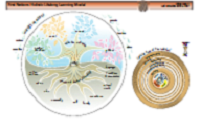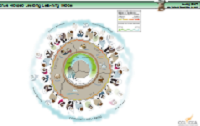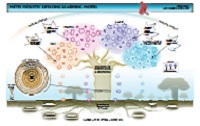 Interconnection is a central core of First Nations, Inuit and Metis worldviews and ways of knowing. Some First Nations sum this up with the phrase “All my relations”. This mindset reflects people who are aware that everything in the universe is connected. It also reinforces that everyone and everything has a purpose, is worthy of respect and caring, and has a place in the grand scheme of life.
Interconnection is a central core of First Nations, Inuit and Metis worldviews and ways of knowing. Some First Nations sum this up with the phrase “All my relations”. This mindset reflects people who are aware that everything in the universe is connected. It also reinforces that everyone and everything has a purpose, is worthy of respect and caring, and has a place in the grand scheme of life.
First Nations relationships fully embrace the notion that people and their families are strongly connected to the communities they live in, their ancestors and future descendants, the land they live on, and all of the plant, animal and other creatures that live upon it. They know they are stewards of the Earth and have traditionally lived in harmony with their environment for millennia. Their traditional practices boast amazing sustainability, ecological awareness and knowledge, and a strong scientific understanding of the earth, weather, cycles of the seasons, medicinal and food sources, marine foods and harvesting, and creating everything they need from nature’s bounty. Before colonization, these practices and systems worked perfectly and in harmony with the world around them. They left a very light footprint upon the earth.
The philosophy and practice of “All My Relations” can teach people a lot about relating to others and to themselves. When we take the time to really ‘be’ with someone we utilize our inner knowing to sense deep levels within the person. Listening attentively and respectfully to what others say, allows us to ‘know’ them better with much more than our rationale minds. This helps us to engage with others in holistic and meaningful ways that support health and well-being. By going further and regarding them as someone who is genuinely connected to us, we go even deeper to feel the inner essence of the person. It is this deep connection that serves as the foundation of relationship with our world, supported by interconnected knowing.
The interconnected relationships with all living things is called the Sacred Circle of Life. First Nations teachings guide us to show respect for all within this Sacred Circle. An intense and deep connectedness with all that surrounds us is a foundational concept of First Nations philosophy. This includes a connection to Mother Earth and all that the Universe contains, including other people (personal relationships, family, neighborhoods, communities, nations), all of the plant beings and four legged brothers and sisters, the finned and flying beings, and ultimately the Great Spirit that animates all.
Preparation
VIEW VIDEOS
Process
EXPLORE HOLISTIC LEARNING MODELS
Take some time to fully view and read about the three holistic life long learning models linked below. Notice the similarities and differences between the three models, and observe how interconnection is presented in each model.

First Nations Model
|

Inuit Model
|

Metis Model
|
The three models (First Nations, Inuit, and Metis) for learning developed by the Canadian Council on Learning, provide wonderful illustrations of interconnectedness applied to learning. The First Nations one is illustrated using the image of a deep-rooted tree. Each aspect of the tree represents an influencing factor that contributes to holistic life-long learning. The model provides both a visual and a text-based explanation of how the connection with one’s self, with others, the community, Elders, and the natural world influence and support learning across the life span.
As you navigate throughout the model, you will notice that the roots represent sources and domains of knowledge (categorized into the domains of self, people, natural world, languages, and traditions). The tree trunk represents the learning rings of the individual, which follows the developmental journey of early learning, elementary and secondary education, post secondary education, workplace learning, adult learning, and intergenerational learning. Finally, the over-arching branches of the tree represent individual and collective well-being, which is further divided into social, spiritual and cultural, political, and economic domains. The community’s collective well-being is manifested through holistic balance of body, mind, heart, and spirit of each individual person.
As you engage with these models, jot down your thoughts and ideas about how interconnection could be applied and improve education for First Nations, Inuit, and Metis people as well as non-Aboriginal people.
Interconnection Expression
Using a medium of your choice, create an artistic expression of what interconnectedness means and what it looks like. Express the essence of this philosophy, and feel it as you create your good work.
Possible mediums you could use include:
☉
Drawing or Painting